Introduction
E-commerce microservices architecture has revolutionized the way businesses manage their online platforms, offering flexibility, scalability, and independence. By decomposing complex systems into smaller, manageable services, businesses can enhance agility and adapt rapidly to market changes. Leading companies like Dunelm Group plc and TBC Bank have successfully adopted microservices to support their digital platforms and streamline operations.
However, transitioning from a monolithic to a microservices architecture is not without its challenges, as demonstrated by Netflix's experience. Nevertheless, the benefits of microservices, such as enhanced scalability, improved resilience, faster time-to-market, flexibility in technology stack, and enhanced customer experience, make it a strategic choice for e-commerce businesses. Moreover, microservices architecture offers advantages in terms of improved security, cost savings, integration with third-party services, testing and issue isolation, global scalability and localization, embracing cloud-native technologies, and incremental modernization.
Real-world examples and case studies highlight the transformative impact of microservices in scaling operations and meeting evolving user expectations. While there are challenges to consider, careful planning and strategic implementation can result in a robust, agile, and efficient digital infrastructure.
What Are E-commerce Microservices?
E-commerce microservices architecture has become a cornerstone for businesses that require a flexible, scalable, and independent system for managing their online platforms. This architecture decomposes complex systems into smaller, manageable services like product catalog management, inventory management, order processing, and payment processing. Each service operates autonomously, enabling them to be developed, deployed, and scaled without dependency on the broader system. This approach not only enhances agility in the digital ecosystem but also allows for rapid adaptation to market changes and customer needs.
Dunelm Group plc, a leading homewares retailer in the UK, exemplifies the efficacy of microservices in supporting large-scale digital platforms. With over 400 million website sessions annually and a significant revenue share from online sales, adopting a microservices architecture has been crucial in their scaling strategy, particularly for their high-performing frontend layer.
Similarly, TBC Bank embraced microservices to simplify operations and reduce technical debt, aligning with their mission to streamline the banking experience. Their agile transformation, supported by microservices, enabled them to tackle organizational complexity and foster growth.
The transition from monolithic to microservices is not a trivial decision, as evidenced by Netflix's experience. Their journey from a monolithic to a microservices architecture highlights the practical benefits and challenges of such a transformation, with the ultimate goal of improving flexibility and scaling capabilities.
Moreover, the retail industry's ongoing technological advancements and the resilience displayed by businesses, as seen in the persistence of in-store technology deployment and the adoption of AI and ML, underscore the importance of a robust e-commerce architecture. Amazon's strategic approach, including sales events like the Great Indian Festival, reflects the potential of microservices in supporting large-scale e-commerce events and promotions.
In the contemporary software landscape, microservices have proven to be a popular choice for developers, with Java being the most utilized language for their development. The trend towards microservices is further evidenced by a decrease in the usage of monolithic architectures with web frontends, indicating a shift in system design preferences towards more distributed and communicative applications.
Benefits of Adopting Microservices Architecture
The e-commerce landscape is constantly evolving, and with it, the need for agile, scalable software architecture. Microservices architecture, a method where applications are broken down into smaller, independent services, has become a popular solution for many businesses, including industry leaders such as the UK's Dunelm Group plc and Georgia's TBC Bank. These companies have experienced firsthand the transformative effects of microservices on their operations.
One substantial benefit of microservices is the modular and flexible structure it provides. This approach enables the development of loosely coupled services, allowing for easier modifications and updates without disrupting the entire system. For instance, Dunelm, a homewares retailer that generates a significant portion of revenue from its digital platform, required a scalable solution to support their growing online sessions. By transitioning to microservices, they could enhance their frontend layer, which is critical for their high-revenue generating website.
Similarly, TBC Bank's agile transformation involved reducing organizational complexity to facilitate growth. The move to microservices played a crucial role in this process, diminishing dependencies between teams and lessening the burden of technical debt. This not only improved the bank's time-to-market for digital products but also provided a better experience for both customers and employees.
The shift from monolithic to microservices architecture is akin to replacing a single, large black box with a set of LEGO bricks. While monoliths offer simplicity, they pose challenges in scaling and can lead to a heavy, unwieldy codebase. Microservices, on the other hand, offer improved scalability. For example, adding a new feature to a monolithic application might require scaling the entire system, whereas with microservices, you can scale just the needed service.
It's not just about the technical benefits; it's about aligning your digital infrastructure with your business goals. Microservices architecture promises not only flexibility and scalability but also the opportunity to explore new methods and improve operational efficiency. This strategic boost is evidenced by the experiences of Netflix, which successfully navigated the transition from monolithic to microservices, overcoming challenges and reaping practical benefits that reshaped their software landscape.
In summary, adopting a microservices architecture offers numerous advantages for e-commerce businesses looking to stay competitive in a dynamic market. By facilitating agility, scalability, and enhanced operational efficiency, microservices architecture is a strategic choice for companies aiming to grow and adapt in the digital era.
Enhanced Scalability
Microservices architecture is a paradigm shift that empowers e-commerce platforms to scale horizontally. Unlike traditional, monolithic infrastructures where scaling up could mean a complete overhaul of the system, microservices allow for the individual scaling of services. This targeted scalability is a game-changer for e-commerce operations which often experience variable and unpredictable traffic loads.
For instance, Dunelm Group plc, a major UK homewares retailer, leverages microservices to manage their significant digital platform traffic, ensuring that their customer's online shopping remains seamless even as they scale. Similarly, PayPal, once a startup, now a global online payment behemoth, faced a staggering volume of transactions that necessitated the adoption of a microservices approach. At one point, to accommodate 1 million transactions daily, they scaled their infrastructure across over 1000 virtual machines.
Netflix offers another noteworthy case, demonstrating the transition from a monolithic to a microservices architecture to handle their expanding user base and service complexities. Such a move exemplifies the strategic value of microservices in supporting growth while maintaining system stability and performance.
The benefits of microservices are evident; they support modularity, flexibility, and resource optimization. Each service functions independently, which not only streamlines development but also enhances the overall agility of the business. This architectural strategy is crucial for e-commerce platforms that demand both resilience and the capability to evolve rapidly in response to consumer and market demands.
Improved Resilience
Microservices architecture, a software development methodology that fragments an e-commerce system into multiple independent services, each with its unique role, significantly enhances system resilience. In the event of a service failure, the architecture's design ensures that the disruption is localized, preventing a domino effect that could incapacitate the entire system. This isolation allows unaffected services to continue operating seamlessly, thereby safeguarding the user experience.
Moreover, services within a microservices architecture can be crafted with self-healing mechanisms, which enable them to recover autonomously from failures. This robust feature is akin to the resilience strategy employed by Amazon ECS, where anticipation of potential failures is a fundamental aspect of their system's design philosophy.
Given the inevitability of some degree of failure, especially at scale, the architecture's resilience is critical. For instance, even with a 99.99% availability rate, a large-scale operation like a million-server setup can expect around a hundred servers to be failing at any given time.
This architectural approach is particularly relevant for substantial online platforms like Dunelm Group plc, a major UK homewares retailer whose digital presence sees over 400 million sessions annually, contributing to 35% of its revenue. As businesses like Dunelm scale, their infrastructure must evolve to support growth, which often leads to the adoption of distributed systems like microservices, especially to enhance the resilience and availability of revenue-critical front-end services.
The distributed nature of microservices, with each running in its own instance and communicating through APIs, aligns with the contemporary computing practice of distributing application components across a network. This strategy not only improves resilience but also allows for scalability and fault tolerance, essential for maintaining service during peak e-commerce periods.
In light of the expected increase in online shopping during the upcoming holiday season, with 57% of consumers planning to make their purchases online, the resilience of e-commerce platforms is more important than ever. The robustness provided by a microservices architecture can ensure that businesses remain operational and responsive to customer needs, even in the face of individual service failures or broader systemic challenges.
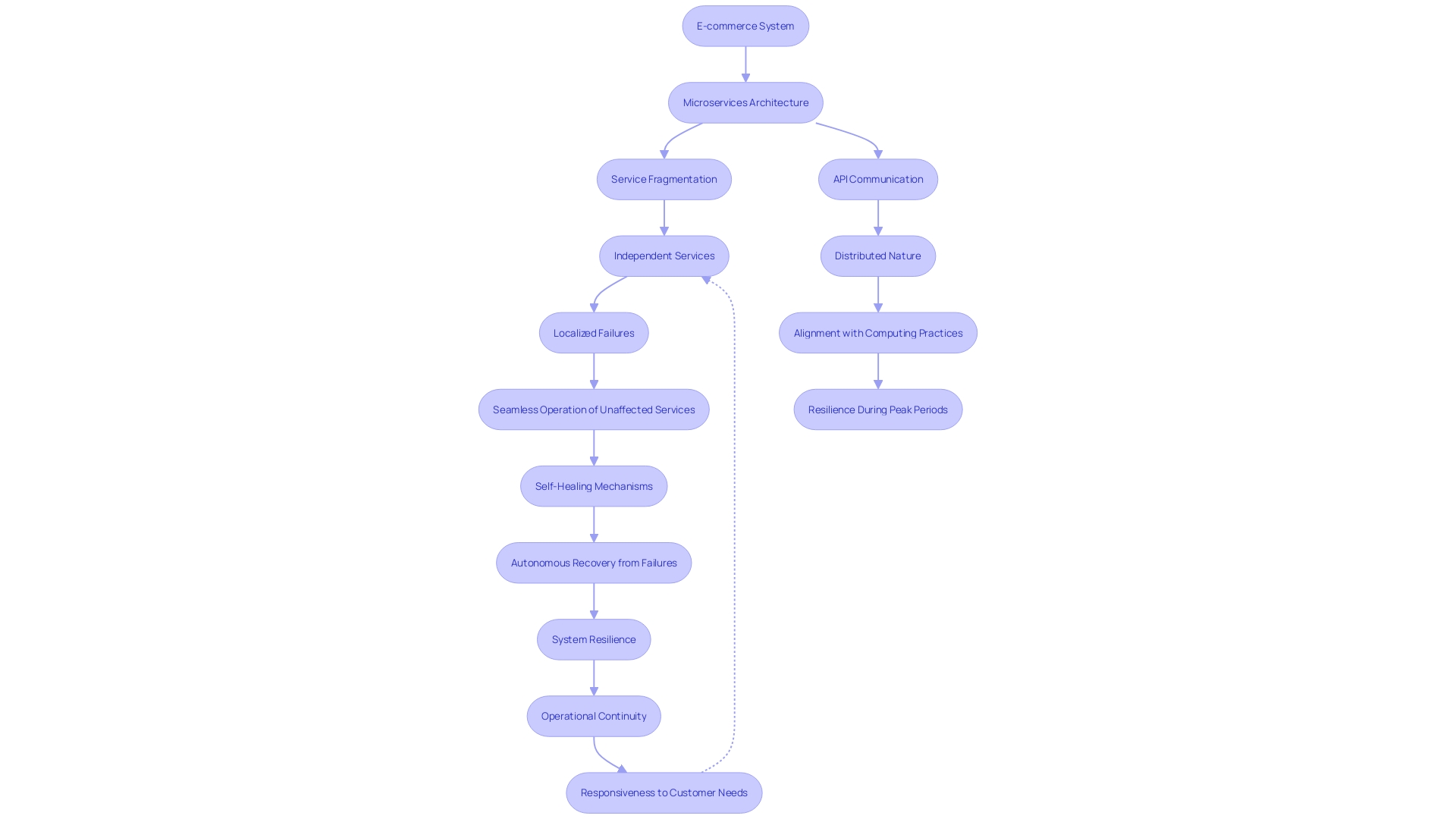
Faster Time-to-Market
Leveraging e-commerce microservices architecture is pivotal for businesses striving to enhance their digital platforms and maintain a competitive edge. By adopting an independent service structure, companies can concurrently develop and deploy new functionalities, which is critical for responding swiftly to customer needs and market trends. For instance, Dunelm Group plc, a major UK homewares retailer, harnesses the power of microservices to manage over 400 million website sessions annually, contributing to 35% of its revenue. This architectural approach not only facilitates faster time-to-market but also fosters a culture of continuous improvement, allowing teams to iterate rapidly and incorporate user feedback effectively. Moreover, with the growing trend of 37% of developers adopting microservices, the increased agility and reduced inter-service dependencies are essential for businesses that prioritize a robust and user-centric online presence. As financial enterprises and technology companies like Bosch and TBC Bank demonstrate, the integration of microservices into their digital strategy empowers them to streamline operations, drive innovation, and ultimately deliver an exceptional user experience.
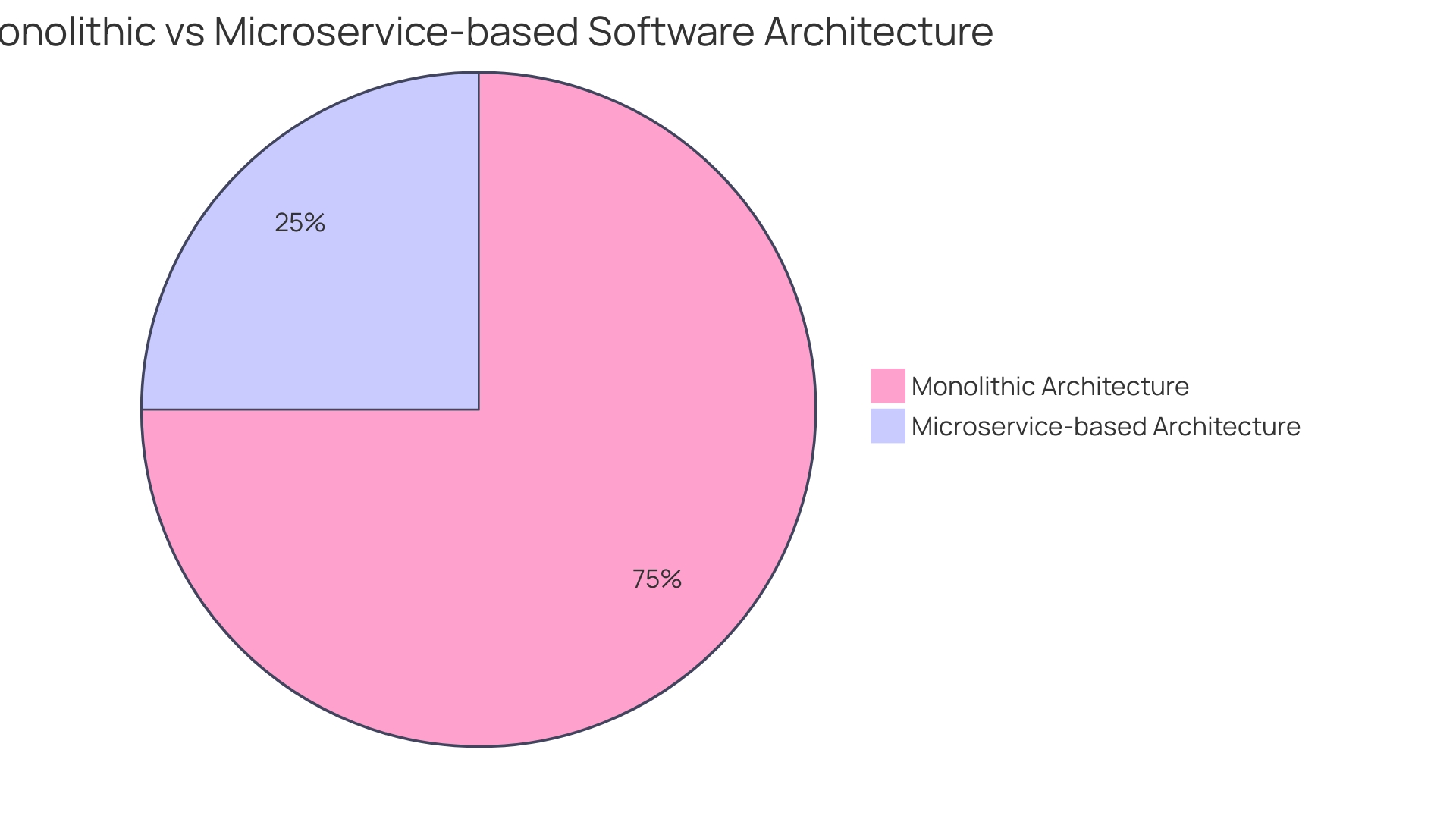
Flexibility in Technology Stack
E-commerce platforms are increasingly adopting microservices architecture to overcome the limitations of monolithic systems. Unlike a monolithic architecture, where applications are a single, indivisible unit, microservices break down an application into smaller, independent services, each handling a specific function. This modular approach not only improves scalability and development speed but also allows for the utilization of diverse technologies and programming languages tailored to each service's demands.
The benefits of this architectural style are evidenced by the experiences of leading organizations. For instance, the UK's premier homewares retailer, Dunelm Group plc, with a significant portion of their revenue generated online, faced the challenge of scaling their digital platform to match their growth. By transitioning to a microservices backend, they were able to enhance the capabilities of their high-revenue-generating frontend layer.
Similarly, global engineering and technology pioneer Bosch has leveraged microservices in their creation of the solid oxide fuel cell (SOFC) system. The SOFC, complemented by a digital twin, benefits from this architecture's ability to support flexible scalability and optimize cost and performance throughout the system's lifecycle.
Recent surveys among retail executives have highlighted a steady increase in the adoption of in-store technology and a prioritization of systems like self-checkout, which can be effectively supported by microservices. This trend is consistent with the move towards more agile, responsive, and customer-centric retail experiences.
By embracing microservices, e-commerce businesses not only future-proof their technology stack but also enhance their ability to integrate with third-party services seamlessly. As Mike Sedzielewski, co-founder of Voucherify, reflects, the adoption of APIs has revolutionized the way his team delivers services, underscoring the transformative potential of microservices architecture in e-commerce.

Enhanced Customer Experience
E-commerce platforms leveraging microservices architecture are redefining the way customers engage with brands. Through a constellation of independently deployable services, businesses like Dunelm Group plc and TotalEnergies Digital Factory have experienced firsthand the agility and customization this approach offers. For instance, Dunelm's digital platform, which accounts for a substantial 35% of their revenue, benefits from the flexibility to evolve specific functionalities that resonate with their customer base.
Similarly, TBC Bank's adoption of an agile framework aligns with their vision of making banking effortless, where microservices play a pivotal role in simplifying operations despite growing technical debt. This architectural style, supported by APIs, ensures that each service is a cog in a larger, well-oiled machine, functioning with a degree of autonomy that traditional monolithic systems simply cannot match.
Anecdotes from the field emphasize the transformative impact of microservices. Shahir A. Daya, from IBM Global Business Services, notes a marked shift away from unwieldy monoliths towards microservices to manage complex codebases effectively. As businesses like TotalEnergies aim to modernize legacy systems, APIs become the linchpin, enabling seamless communication between services. Such strategic moves are not just about technology but are integral to a company's broader objectives, optimizing resources and enhancing operational efficiency.
Incorporating microservices into the e-commerce architecture is more than a trend; it's a strategic pivot towards a digital-first, customer-centric approach. With the capacity to scale specific services independently and adapt rapidly to market demands, this modular architecture paves the way for a personalized and frictionless customer experience.
Operational Efficiency
Harnessing the power of microservices architecture is a transformative strategy for e-commerce businesses seeking to enhance their operational efficiency. By decentralizing development efforts, businesses can assign dedicated teams to individual services, enabling a more focused and agile workflow. This autonomy promotes rapid iterations, a crucial advantage in the fast-paced digital marketplace. The discrete nature of microservices also offers a streamlined approach to updates and problem-solving, ensuring any issues can be isolated and addressed promptly without cascading impacts.
Take, for example, Dunelm Group plc, a leading UK homewares retailer with substantial digital presence. As the company scaled, it recognized the need for a software architecture that could support its growth. By adopting a microservices approach, Dunelm was able to reflect its expansion both organizationally and in its digital offerings, which are critical to their revenue stream.
Similarly, PayPal's early adoption of a microservices infrastructure allowed them to manage an explosive increase in user transactions, reaching a milestone of 1 million transactions a day. Their strategic investment in distributed systems enabled them to efficiently scale their operations in line with user demand.
These narratives underscore the strategic value of microservices in supporting scalability and maintaining a high level of service quality. As businesses like S Group in Finland continue to invest in technology to enhance their retail operations, the shift towards microservices is a clear indicator of its role in future-proofing e-commerce platforms. The architecture's ability to allow each service to perform distinct functionalities, communicate via API, and be independently scaled is a robust answer to the modern retail challenges.
Improved Security
Microservices architecture, an approach that decomposes an application into loosely coupled services, each responsible for discrete business capabilities, offers enhanced security for e-commerce platforms. By segmenting sensitive functions into distinct services, the architecture creates barriers that can help contain security breaches, limiting their potential impact. This modular nature allows for precise access control, as services can be specifically authorized to engage with sensitive data or execute crucial operations, akin to having dedicated bouncers for each room in a club, ensuring only approved users gain entry.
The benefits of this approach are underscored by the experiences of leading retailers. For example, Dunelm Group plc, a major homeware retailer in the UK, with significant revenue generated through their digital platform, had to adapt their software architecture to match their growth and ensure robust security. Similarly, an e-commerce business looking to expand in Africa sought an architectural design to deliver low-latency, secure, and fast data retrieval, demonstrating that regardless of the size or budget, the need for secure, fault-tolerant, and available systems is paramount. This is particularly crucial given the average $5.66 million cost of a data breach in the retail sector and the pressing need for cybersecurity to be integrated into business strategy to safeguard consumer trust and commercial viability.
Deploying microservices aligns with these needs, providing a framework for enhanced security measures while supporting the agility required in the dynamic e-commerce landscape. Whether utilizing an API Gateway for centralized access management or allowing each microservice to manage its own access, the overarching goal remains the same: ensuring secure, efficient, and reliable online retail operations.
Cost Savings
E-commerce businesses that transition to a microservices architecture can experience significant cost efficiencies. By adopting a modular approach, companies can more precisely scale their resources to match fluctuating demand, leading to optimized infrastructure spending. This agility in scaling is crucial for e-commerce platforms, which often experience variable traffic patterns. For instance, during peak shopping seasons or promotional events, the ability to independently scale services ensures that customer experience remains smooth without incurring unnecessary costs during quieter periods.
Microservices also promote more streamlined and effective team workflows. With services being developed and managed independently, teams can focus on specific areas of the e-commerce platform without being hindered by the complexities of a tightly coupled system. This independence reduces cross-dependency issues, allowing for faster development cycles and more efficient maintenance, ultimately cutting down on labor costs.
The flexibility in technology choice is another financial advantage of microservices. Traditional monolithic architectures can lock businesses into specific technology stacks, but microservices empower companies to select the most cost-effective and suitable tools for each service. This adaptability is particularly beneficial for e-commerce platforms that must stay competitive by quickly adopting new technologies to enhance user experience and operational efficiency.
Case studies from various industries underscore these benefits. For example, Dunelm, a UK-based homewares retailer, leveraged microservices to support its digital platform, which accounts for a significant portion of its revenue. The ability to adapt its architecture to match its business growth was critical for Dunelm's success. Similarly, Bosch's implementation of a microservices architecture for its SOFC system allowed for optimal cost and performance management throughout the system's lifecycle. TBC Bank's agile transformation, which included a shift to microservices, aimed at reducing organizational complexity to facilitate growth. These examples reflect the diverse applications and cost-saving potential of microservices in different sectors.
In summary, e-commerce businesses can achieve substantial cost benefits by embracing microservices. These include more efficient resource scaling, improved team productivity, and the freedom to choose the most appropriate and economical technologies.
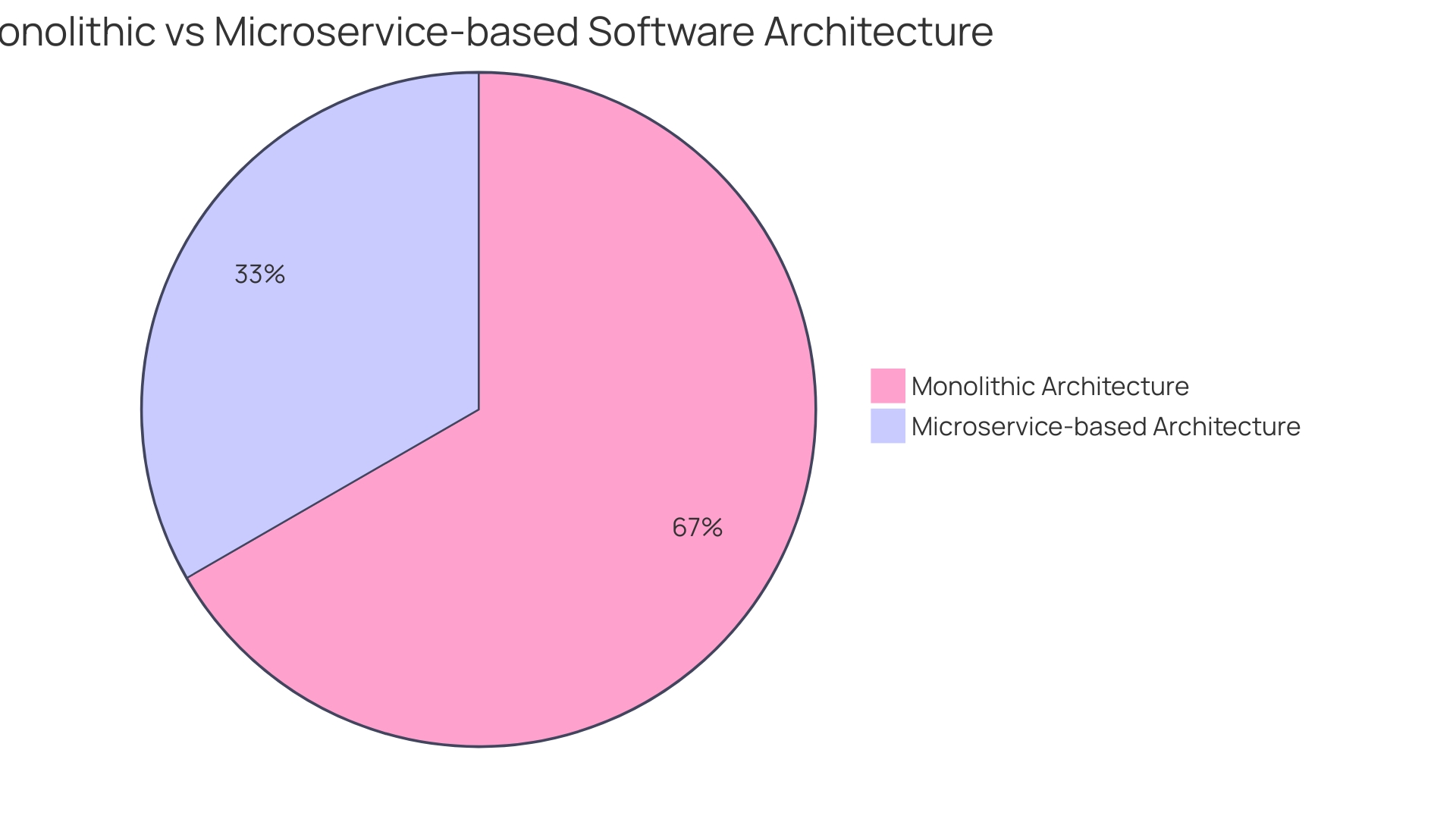
Integration with Third-Party Services
E-commerce systems benefit immensely from microservices architecture due to its ability to integrate effortlessly with a variety of third-party services. By structuring each microservice to manage a distinct aspect of the system, such as payments or logistics, businesses can employ APIs to establish clear communication channels with external providers. This approach not only simplifies the exchange of data but also empowers e-commerce platforms to incorporate specialized functionalities from third-party solutions, enhancing the user experience.
A case in point is Dunelm Group plc, the UK's leading homewares retailer, which has successfully scaled its digital platform to support a significant portion of its revenue by transitioning to a microservices-based backend architecture. Similarly, the story of Voucherify demonstrates the transformative impact of utilizing external APIs, allowing the company to expedite their development process and integrate their service into the tech stacks of major brands.
Practical examples of this integration include the management of inventory and product data. By separating these concerns into distinct services and consolidating them into a central catalog database, businesses can maintain an accurate source of truth. This enables more effective product search and filtering capabilities, further contributing to a seamless customer journey.
Moreover, the importance of APIs as the cornerstone of modern software development cannot be overstated. As noted by Google, they are considered the "crown jewels" of the industry, facilitating innovation and collaboration among developers and stakeholders. The strategic use of APIs in e-commerce aligns with the ongoing trend of prioritizing sales and technology deployment, as evidenced by recent surveys of retail executives.
Ultimately, the adoption of microservices and the strategic integration of third-party APIs are critical steps for e-commerce platforms aiming to scale and enhance their offerings, thereby meeting the evolving demands of the digital marketplace.
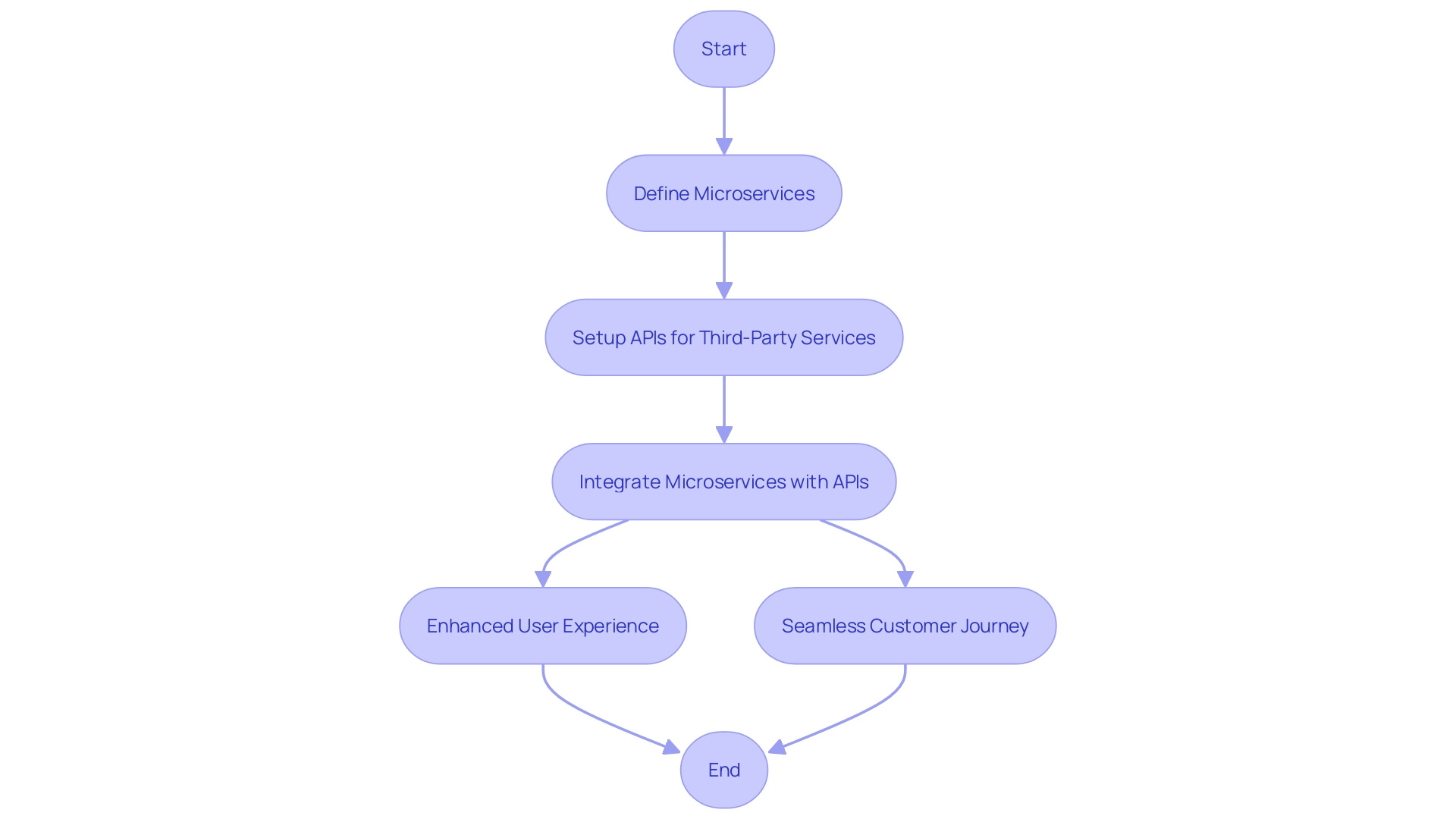
Testing and Issue Isolation
Adopting microservices architecture is not just about breaking down a software system into manageable pieces; it's a strategic move towards more resilient and agile development processes. With individual services encapsulated into focused modules, it's easier for teams to conduct rigorous testing for each service, ensuring they function as intended without entangling with the complexities of the entire system. This targeted approach to testing is not only efficient but also reduces the risks associated with deploying updates or new features.
This principle was exemplified by Allegro, one of Central Europe's e-commerce giants, which embraced a microservices-driven overhaul to address development bottlenecks. Their transformation shows that isolating services can significantly enhance the capability to identify and resolve issues, thereby minimizing downtime and improving the user experience for millions of their customers.
Moreover, the microservices model champions the 'Divide and Conquer' approach, allowing developers to conquer intricate challenges by dividing them into smaller, more manageable tasks. This strategy is fundamental to improving a product's efficiency, as evidenced by the progress in software quality and testing over the past decade. Reports indicate a shift towards automation and shorter, higher quality life cycles, underscoring the importance of adaptable architectures like microservices.
Furthermore, the architecture's modularity aligns with the principle of separation of concerns, a mindset that simplifies complexity and boosts the quality of code. It's clear that the independence afforded by microservices leads to more testable and maintainable systems, as emphasized by software engineering experts.
While microservices offer numerous benefits, such as ease of deployment and the ability to choose technology best suited for specific functions, it's crucial to acknowledge the system's complexity as a whole. Communication between services, for instance, poses challenges that require careful consideration.
In conclusion, the shift to microservices is a strategic decision that brings about a more robust and flexible development environment, leading to faster issue resolution and enhanced product quality. As the tech world evolves, this architectural choice continues to prove its worth in creating software that can adapt rapidly to changing market demands.
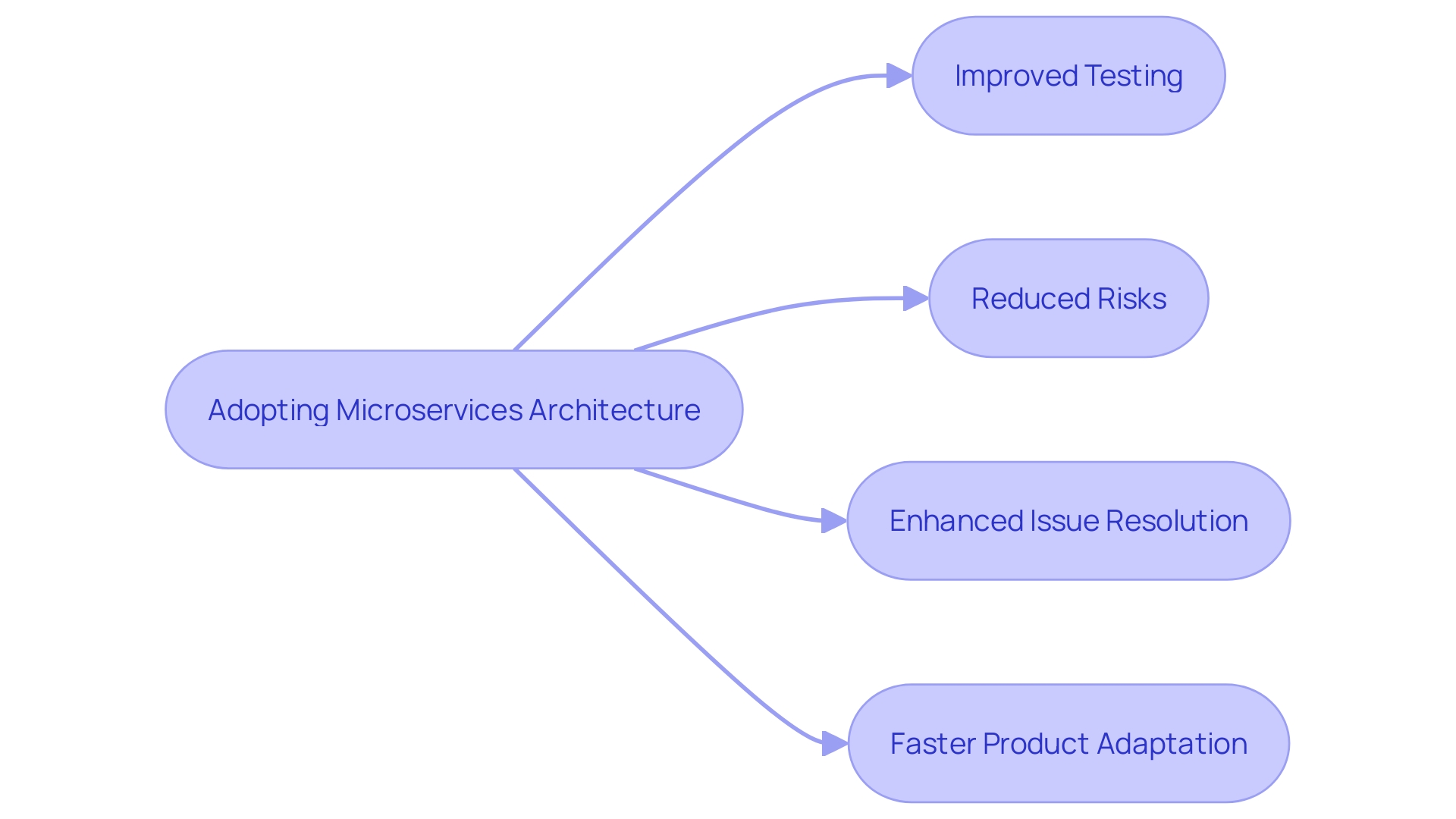
Global Scalability and Localization
E-commerce microservices architecture serves as a powerful tool for businesses aiming to adapt and thrive in the global market. By decomposing an application into a collection of smaller, interconnected services, companies like Dunelm Group plc and Nubank have harnessed the benefits of microservices to cater to diverse customer needs and preferences across various regions. Microservices enable each service to be independently developed, deployed, and scaled, fostering agility and reducing technical debt, as in the case of TBC Bank's digital transformation.
Utilizing microservices, organizations can effortlessly customize their offerings to align with local languages, currencies, and payment methods, thereby optimizing their operations for each specific market. This approach not only simplifies the management of complex, region-specific requirements but also maximizes resource utilization, ensuring that the digital infrastructure can scale in tandem with user demand. With the adoption of microservices, businesses are equipped to provide a seamless and tailored shopping experience to a global audience, ensuring that every customer interaction is as personal and localized as if it were in a neighborhood store.
The architectural shift to microservices is not merely a technological upgrade but a strategic enhancement that aligns with business objectives. Companies leveraging platforms like Azure to build their microservices benefit from a modular and flexible ecosystem, which underpins a nimble and scalable digital presence capable of handling traffic spikes without disruption. In the ever-evolving landscape of e-commerce, the microservices architecture is a pivotal element in building a resilient, customer-centric online platform that can dynamically adapt to the pulsating nature of global online commerce.
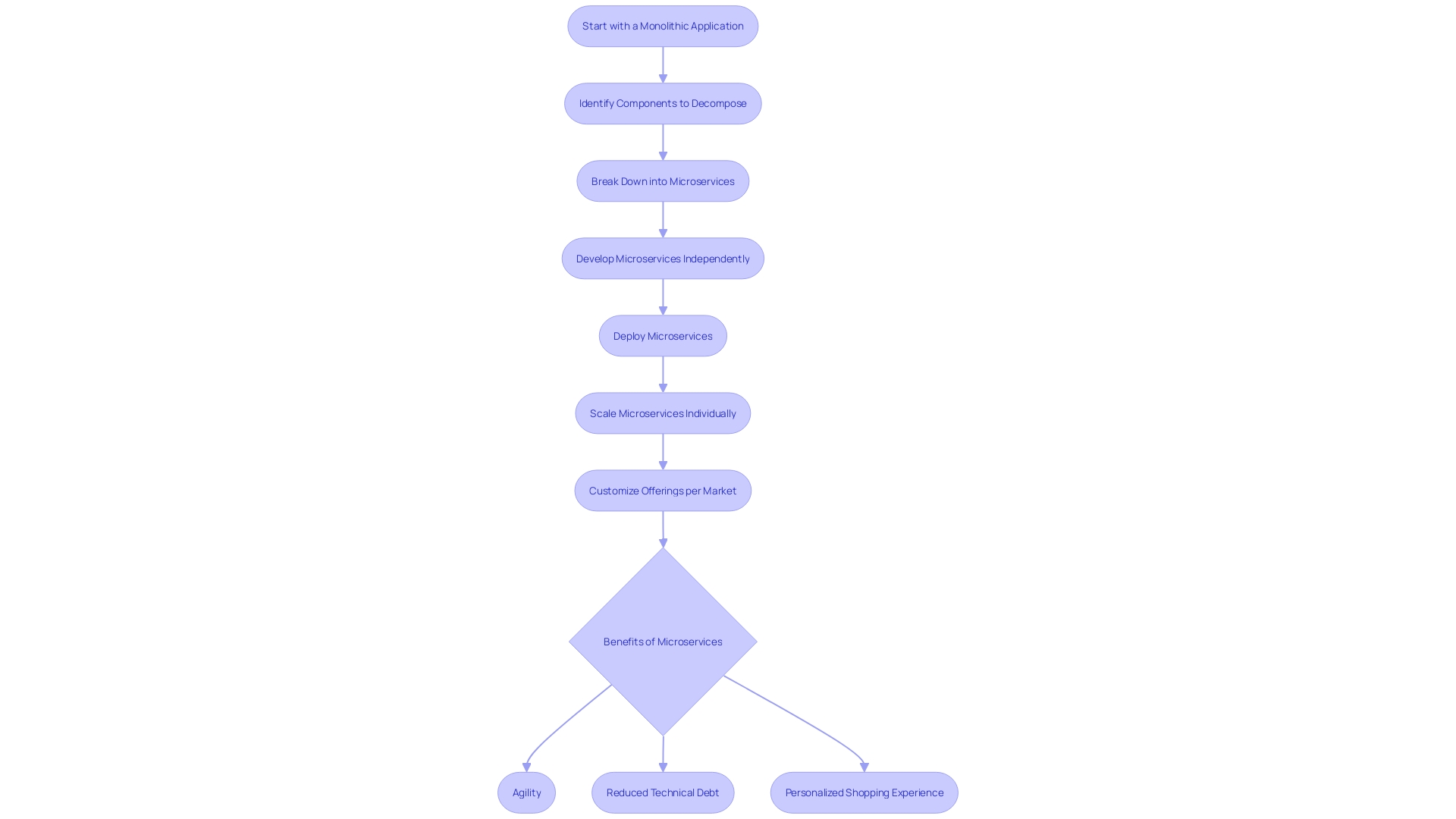
Embracing Cloud-Native Technologies
Microservices architecture has taken center stage in modernizing e-commerce infrastructure, offering a level of agility and scalability that traditional monolithic architectures struggle to match. By breaking down applications into smaller, independent services that communicate through APIs, microservices facilitate rapid development cycles and more efficient deployment practices. Retail giants like Dunelm Group plc, which garners a substantial portion of its revenue from online sales, have recognized the pressing need to evolve their digital platforms in parallel with their growth. Dunelm's adoption of a microservice-based backend architecture exemplifies this shift towards distributed systems that cater to high-traffic e-commerce operations.
The embrace of cloud-native technologies has been instrumental for companies like Nubank, which started with a cloud-first mentality, building hundreds of microservices to support its global customer base. This approach demonstrates the synergy between cloud infrastructure and microservices, leveraging standardized and homogenous tech stacks to maintain fewer solutions for similar problems while evolving the system as a whole.
Even in the realm of engineering and technology, where Bosch focuses on sustainable energy solutions, microservices play a pivotal role. The digital twin supporting Bosch's SOFC system epitomizes the intersection of physical and digital engineering, offering scalability and high-efficiency in energy conversion. The digital twin's ability to provide real-time monitoring and optimization of the SOFC system echoes the advantages that microservices architecture brings to e-commerce platforms—enhanced performance management, and cost-efficiency over the system's lifecycle.
Statistics indicate a continued growth in cloud service adoption, with reports highlighting the significant value cloud brings in IT productivity, business innovation, and the incorporation of advanced technologies like generative AI. These trends underscore the importance for e-commerce leaders to maximize their cloud ROI, as cloud and microservices together form the backbone of a robust, scalable, and resilient e-commerce infrastructure that can adapt to the evolving demands of the retail industry.
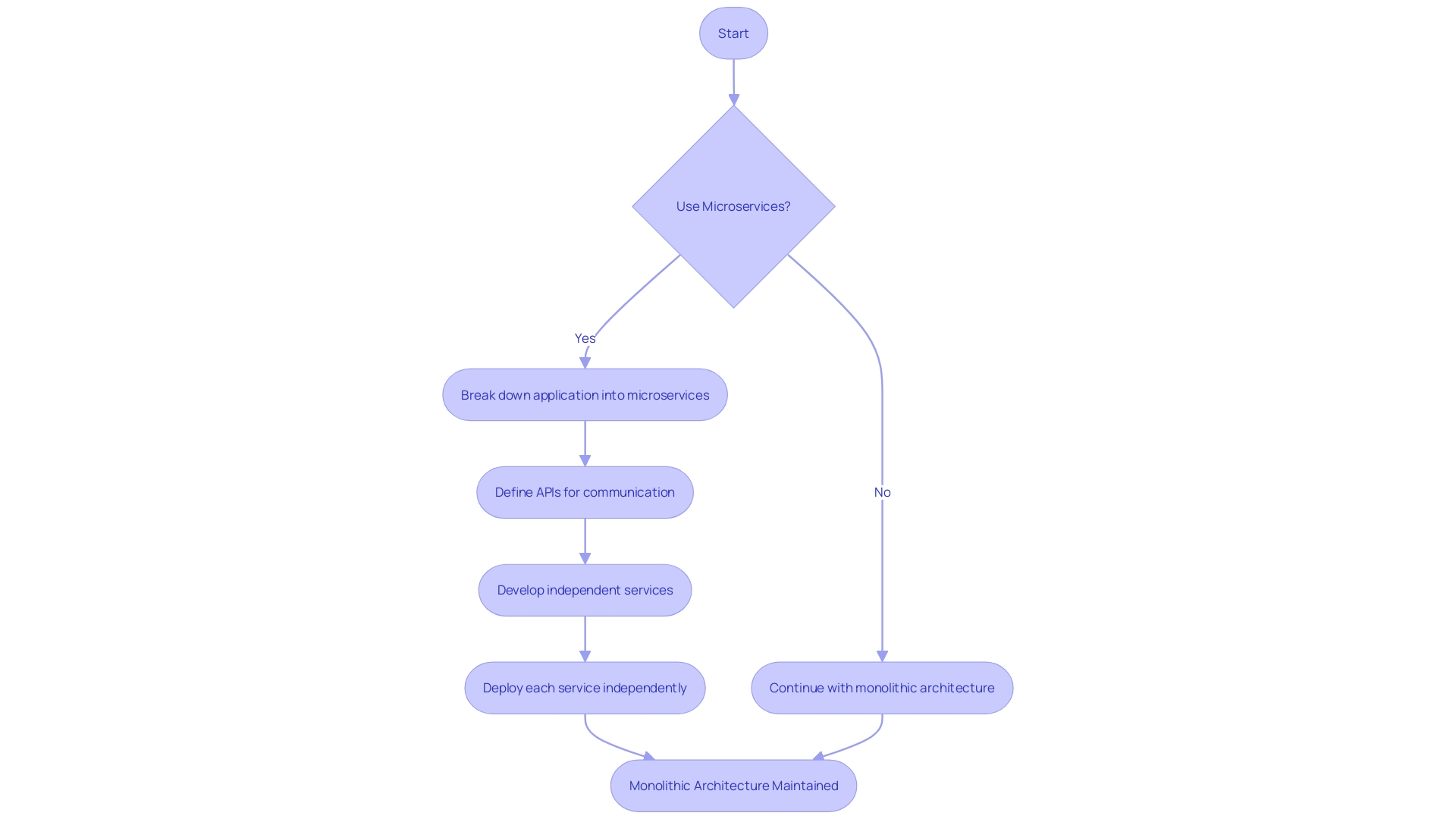
Incremental Modernization
The evolution of e-commerce platforms has required a strategic approach to system modernization, where microservices architecture plays a transformative role. By transitioning from a monolithic system, where all operations are tightly interwoven, to one where services operate independently, businesses can incrementally modernize their e-commerce systems. This does not necessitate a complete system overhaul but allows for the gradual migration of individual functionalities to microservices.
For instance, Dunelm Group plc, the UK's leading homewares retailer, recognized the need to evolve their digital platform to support their growth. With their website generating roughly 35% of their revenue from over 400 million annual sessions, a shift to microservices allowed them to refactor their backend systems without disrupting their high-performing frontend.
The benefits of microservices are evident in the substantial development bottlenecks that were cleared at Allegro, one of Central Europe's largest e-commerce sites. The adoption of a microservices architecture, coupled with a culture of learning and an empirical approach to development, led to faster development and a more resilient, scalable system.
In the broader scope of application modernization, companies face the perennial challenge of legacy systems that fail to meet changing market demands, exhibit long feature development lead times, and constrain new feature design. Microservices offer a solution to these issues by enabling flexible, scalable, and maintainable systems.
By understanding the characteristics of legacy systems, as suggested by Stratoflow CTO Arkadiusz Drysch, who humorously regards any deployed system as 'legacy,' organizations can better decide when and how to adopt microservices. This decision, driven by factors such as the need to remain competitive and meet evolving user expectations, can lead to a significant improvement in functionality, performance, security, and user experience of e-commerce platforms.
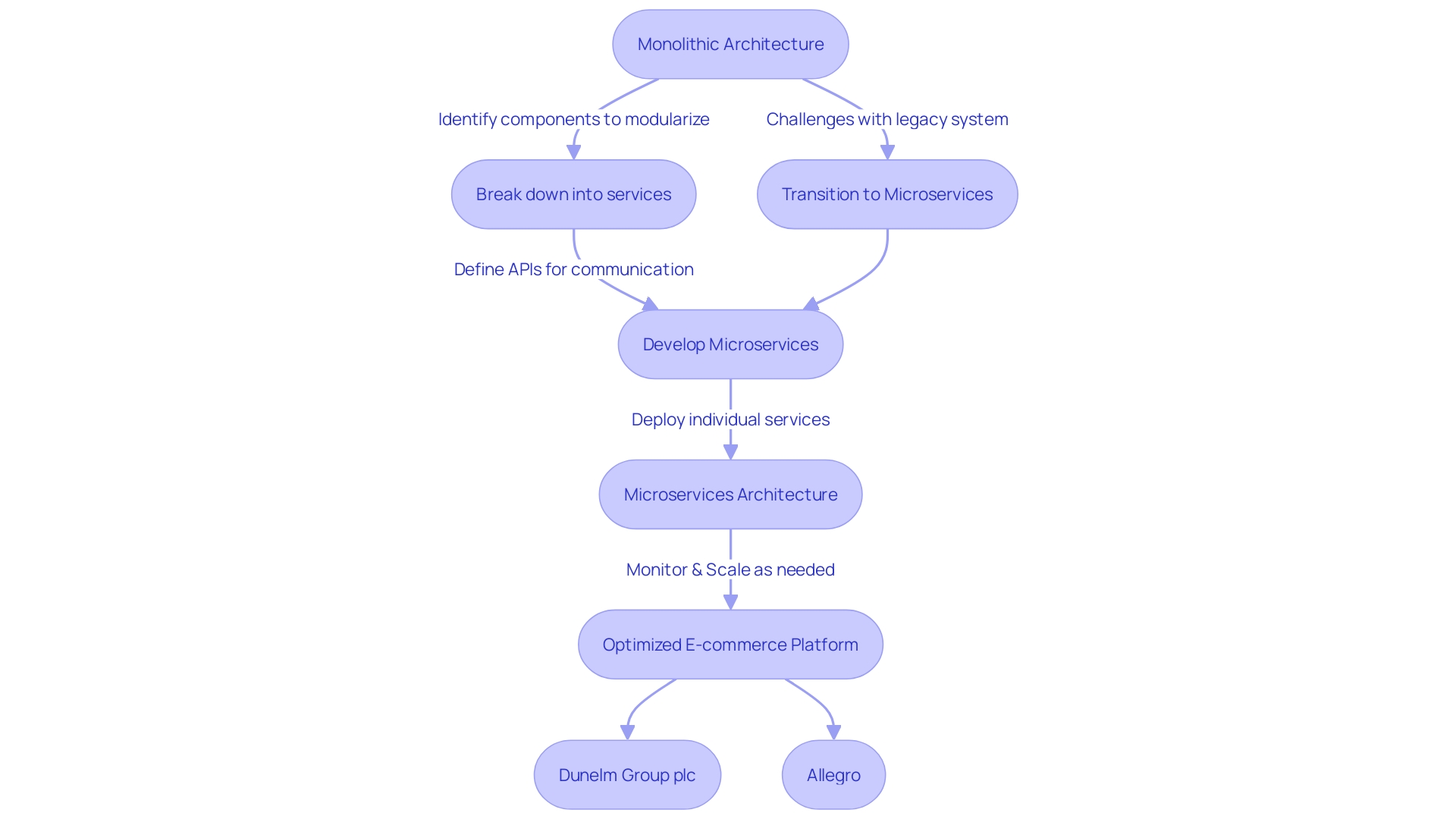
Real-World Examples and Case Studies
Exploring the transformational journeys of companies like Dunelm Group plc, a UK homewares leader, sheds light on the pivotal role of e-commerce microservices architecture in scaling operations. Dunelm's digital platform, accounting for 35% of its revenue with over 400 million annual sessions, underscores the necessity of evolving software architecture to keep pace with organizational growth. Microservices, characterized by smaller, independent services each responsible for discrete functions, contrast sharply with the monolithic approach, where applications are developed as a single, intertwined unit. The latter, while initially simpler, can hinder scalability and accelerate development bottlenecks as complexity mounts.
In the field, professionals like Shahir A. Daya from IBM Global Business Services have witnessed the transition from unwieldy codebases to more manageable, modular microservices. The architectural shift enables companies to streamline code refactoring efforts and overcome the inherent challenges of updating monolithic systems. Moreover, the autonomous nature of microservices facilitates independent development, deployment, and scaling, which is essential for meeting the dynamic demands of e-commerce.
A real-world application of this approach is evident in the work of a Full Stack Developer who leveraged .NET 8 API and Entity Framework Core to construct a suite of microservices, each serving a unique function within a larger, cohesive system. This project not only demonstrates the technical underpinnings of microservices but also their practical implementation in a high-stakes, revenue-generating environment.
Java's prominence in microservices development, used by 34% of developers, further illustrates the gravitation towards languages and frameworks that support the architectural paradigm. Such statistical insights reinforce the trend towards microservices as a viable and advantageous strategy for e-commerce entities aspiring to expand and excel in the digital marketplace.
Challenges and Considerations
Adopting a microservices architecture is pivotal for companies like Dunelm Group plc, the UK's premier homewares retailer. With over 400 million website sessions annually and a significant portion of revenue generated online, the shift toward a modular, flexible system is not just an upgrade, it's strategic leverage for growth. Microservices architecture allows businesses to build applications as a suite of small, independent services, each addressing a specific business function. This autonomy lets services be developed, deployed, and scaled on an individual basis, which is crucial for high-traffic sites.
Yet, transitioning to microservices can introduce hurdles such as inter-service communication and maintaining data consistency. These services must 'talk' to each other effectively, despite their independence, to ensure a seamless user experience. Data consistency is another critical aspect, as each service might have its own database. Techniques like distributed transactions and event-driven communication are often employed to tackle these challenges.
Service discoverability also becomes essential in a microservices environment. It ensures that the services can find and communicate with each other within a dynamic landscape where services are continuously deployed and updated. This can be managed through service registries and dynamic service discovery mechanisms.
Monitoring is another facet that demands attention. With each service running independently, understanding the system's overall health requires a more granular monitoring approach. Implementing comprehensive logging and monitoring at the service level can provide insights necessary for maintaining performance and stability.
Shahir A. Daya, who has led significant microservices projects, emphasizes the advantages of this architecture. He points to the benefits of scalability and independence which can address the complexity and unwieldiness of monolithic codebases. By examining real-world applications of microservices, like those by Daya at Fortune 100 companies, it's clear that careful planning and strategic implementation can result in a robust, agile, and efficient digital infrastructure.
Conclusion
E-commerce microservices architecture has revolutionized the way businesses manage their online platforms, offering flexibility, scalability, and independence. By decomposing complex systems into smaller, manageable services, businesses can enhance agility and adapt rapidly to market changes. Leading companies like Dunelm Group plc and TBC Bank have successfully adopted microservices to support their digital platforms and streamline operations.
However, transitioning from a monolithic to a microservices architecture is not without its challenges, as demonstrated by Netflix's experience. Nevertheless, the benefits of microservices, such as enhanced scalability, improved resilience, faster time-to-market, flexibility in technology stack, and enhanced customer experience, make it a strategic choice for e-commerce businesses. Moreover, microservices architecture offers advantages in terms of improved security, cost savings, integration with third-party services, testing and issue isolation, global scalability and localization, embracing cloud-native technologies, and incremental modernization.
Real-world examples and case studies highlight the transformative impact of microservices in scaling operations and meeting evolving user expectations. While there are challenges to consider, careful planning and strategic implementation can result in a robust, agile, and efficient digital infrastructure.
In conclusion, adopting a microservices architecture offers numerous advantages for e-commerce businesses looking to stay competitive in a dynamic market. By facilitating agility, scalability, and enhanced operational efficiency, microservices architecture is a strategic choice for companies aiming to grow and adapt in the digital era.





